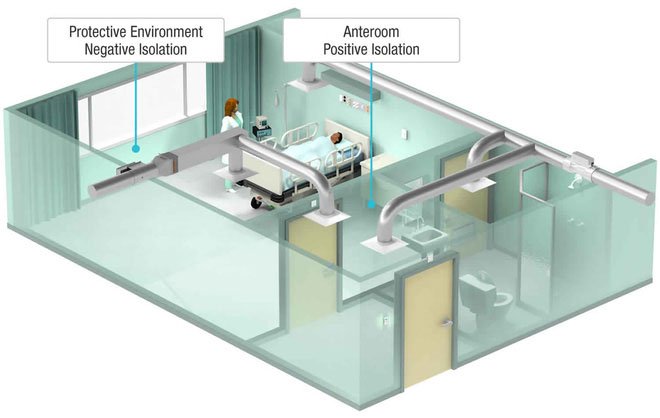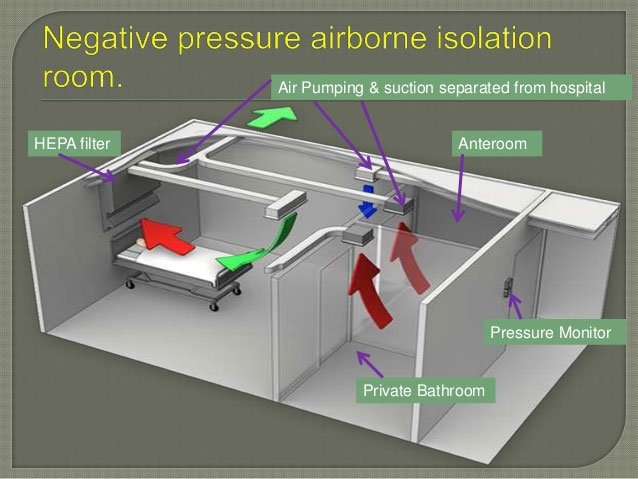What is the negative pressure room to isolate Covid-19 patients?
As its name suggests, a negative pressure room is a room with lower pressure around it, where air can only come in from one side and cannot escape through that side.
When the number of SARS-CoV-2 infections in Korea reached nearly 3,000, health officials said they had prepared 1,077 negative pressure isolation rooms for patients with symptoms of impairment. heaviest breathing.
Jeong Eun Kyeong, head of the Korean Centers for Disease Control and Prevention (KCDC), said the negative pressure rooms were only prioritized for critically ill patients, requiring intensive care.
Patients who are positive for Covid-19 but have milder symptoms will be isolated in a regular hospital room or at home. So what is the negative pressure isolation room? How do they play a role in preventing the spread of disease?
Let's find out in the article below.


How SARS-CoV-2 virus is spread in the environment
We know that the virus that causes Covid-19 can be spread through droplets that people spread into the air. Research shows that when an infected person sneezes, they can spread into the air 40,000 splashes. These droplets can travel up to 6 m at a speed of 50 m / s.
When a person coughs or talks for 5 minutes, they can spread 3,000 drops of shot. Cough drops when coughing can travel over a range of 2 m at a speed of 10 m / s. And even when an infected person breathes, they can spread droplets over a range of 1 m at a velocity of 1m / s.
The path of the droplets is even more complicated when the airflow in a hospital moves freely. Air will travel from high pressure to low pressure. They can carry droplets of virus from a patient in the room to the corridor, infecting other doctors and patients there.
The virus can even spread from room to room. Therefore, control of this cross-infection pathway should be prevented. To do this, hospitals have built special isolation rooms called negative pressure rooms .

Respiratory pathogens can spread through normal disease rooms, creating a risk of cross-contamination.
What is negative pressure room?
As its name suggests, a negative pressure room is a room with lower pressure around it, where air can only come in from one side and cannot escape through that side. Imagine standing in front of this room, the wind will always blow from outside the door to the inside.
If a patient with Covid-19 infection is quarantining it, their virus-containing droplets will not be able to swim upstream to escape outside the door. At this point, cross-infection of air flow between patients will be extinguished.
Negative pressure rooms like these are usually built in the hospital's infectious disease isolation section. It was often used to isolate patients with tuberculosis, measles, chicken pox, influenza, SARS, Ebola and now Covid-19.

Path of air and pathogens in the room of negative pressure.
To create lower pressure from one side of the room, it would have to be as tight as possible, with a monolithic ceiling, tight doors - only a gap under the wing at a height of about half an inch, similar to equivalent to 1.27cm.
Windows (if applicable) must also be tight and sealed. The electrical outlet, lines, pipes coming into and out of the room must also ensure that there is no opening.
After that, the pressure in the room will be reduced thanks to an inlet pump system. Air will be drawn out of the negative pressure room through a pipe, usually located near the head of the hospital bed.
This airflow will of course carry droplets containing Covid-19 pathogens. To ensure this pathogen is retained, the hospital will use a HEPA (High-efficiency particulate air) filtration system .
HEPA filter systems are designed with glass-fiber filters and the gaps between them are only 0.3 micrometres apart. But the special feature of HEPA compared to other filtration systems is that it is able to capture particles smaller than the gap size by taking advantage of diffusion and electrostatic suction mechanisms.
In comparison, droplets of pathogens are also often dozens of micrometers or more. As a result, HEPA filters can treat the air in the suction line from the negative pressure room to ensure an absolute cleanliness (> 99.99%).
The SARS-Covid-19 virus will remain on these filters until they die or are killed when the HEPA filter is disinfected and replaced by hospital technicians.

Diagram of a negative pressure room in a hospital.
Air compensating for negative pressure room is the natural clean air stream, drawn from the inlets. The volume of air circulating in a negative pressure room per hour is usually 12 times the volume of the room. Therefore, it is understandable that the entire air in the room will be renewed every 5 minutes.
Placing air intakes and air compensators in a negative pressure room is also very scientific. Accordingly, the inlets are usually located at the head of the patient's bed, closest to their breath. This ensures that even when a doctor visits the patient's bed, it is difficult for the patient's breath to reach the doctor's airways.
In contrast, the air inlets in the negative pressure room will be placed high, at the rear of the hospital bed to create a clean air flow. Inside a negative pressure isolation room, there are usually facilities, including toilets.

Diagram of an air path in a negative pressure room.The air will only go in one direction, from the anteroom to the patient room and ends in the bathroom.
The lavatory itself is another negative pressure room, where air can only enter and not exit. It will ensure that the germs will not spread back from the toilet to the isolation room where the sick person is located.
In the US, sound pressure isolating rooms are often recommended to have both telephone and TV sockets to serve the entertainment needs of patients. In addition, they can even set up a cycling machine in which the sick person can exercise.
- Students returning to school after a break from Covid-19: What do parents need for the school?
- The cell adhesion capacity of SARS-CoV-2 virus is 1,000 times stronger than SARS
- Successful preparation of oral Covid-19 vaccine
- Things to do during home isolation to prevent Covid-19 from spreading
- Staying in a room with a low temperature can be a cause of high blood pressure
- Covid-19 classification chart of people infected with HIV needs to be sure
- Why does Vietnam treat 16/16 patients with COVID-19?
- WHO collaborates with the Ministry of Health to provide necessary precautions when working to prevent Covid-19
- What should I pay attention to on New Year's Day?
- Why is the mortality rate for Covid-19 virus in Iran so alarming?
- 4 patients sharing a room will increase the chance of infection for each other by 20%
- Patients in Hai Phong: Negative for H5N1!
- China already has anti-coronavirus drugs on the market
- Things to do when fever, cough, sore throat
- Scientific methods help limit negative thoughts to live better
 Chinese doctors have created medical masks that cover only the nose for convenience of eating and drinking
Chinese doctors have created medical masks that cover only the nose for convenience of eating and drinking Scientists have found a way to help you regrow new teeth after only 2 months
Scientists have found a way to help you regrow new teeth after only 2 months Do non-stick pans cause cancer? What alternatives are there?
Do non-stick pans cause cancer? What alternatives are there? Blisters around the body: Causes, symptoms and treatment
Blisters around the body: Causes, symptoms and treatment Don't let the movies fool you, ancient people had to complete these 7749 procedures to rent an inn.
Don't let the movies fool you, ancient people had to complete these 7749 procedures to rent an inn.  New discoveries about the role of women in ancient Moche culture
New discoveries about the role of women in ancient Moche culture  Discovered frescoes of Trojan mythological characters in Pompeii
Discovered frescoes of Trojan mythological characters in Pompeii  Found a slave room buried for 2,000 years under volcanic ash
Found a slave room buried for 2,000 years under volcanic ash  The most silent room on Earth, people go 'going crazy' after 45 minutes
The most silent room on Earth, people go 'going crazy' after 45 minutes  Remote eavesdropping technique thanks to light bulb vibration
Remote eavesdropping technique thanks to light bulb vibration 